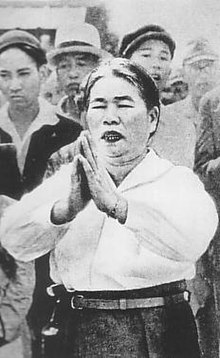Tenshō Kōtai Jingūkyō


Tenshō Kōtai Jingūkyō (Japanese 天照皇大神宮教) is a Japanese new religious movement which emerged from Shinto. It was established by Sayo Kitamura (北村 サヨ) (1900–1967), with activities beginning in 1945. The movement includes 450,000 members.[1] Kitamura claimed possession by Amaterasu under the title Tenshō-Kōtaijin.
Its headquarters are in Tabuse (田布施町, Tabuse-chō), a town in the district of Kumage District, Yamaguchi, Japan.
Followers practice a dance called muga no mai (無我の舞, "Dance of the non-self" or "Dance of the non-ego"), which is why the religion is called the "dancing religion" (踊る宗教, Odoru shūkyō).
See also
- Anatta / Anātman (jap. muga)
References
- ^ "Glossary of Shinto Names and Terms: T". www2.kokugakuin.ac.jp (in Japanese). Retrieved 2018-10-16.
Further reading
- The Prophet of Tabuse (1954), published by Tensho-Kotai-Jingu-Kyo, Tabuse, Yamaguchi prefecture, Japan.
- Tina Hamrin: Dansreligionen i japansk immigrantmiljö på Hawai'i. Via helbrägdagörare och Jodu shinshu-präster till nationalistisk millennarism. (English summary: The Dancing Religion in a Japanese-Hawaiian Immigrant Environment). Stockholm: Almqvist & Wiksell International, 1996. (Acta Universitatis Stockholmiensis. Stockholm Studies in Comparative Religion) - Review
- NISHIYAMA Shigeru & FUJII Takeshi: The Propagation and Spread of Tenshô Kôtai Jingûkyô within Japanese-American Society on Hawaii Island at the Wayback Machine (archived 2014-04-21). 1991, 1997 Institute for Japanese Culture and Classics, Kokugakuin University.
- Clark B. Offner: The Work of the Holy Spirit in the Japanese Cultural Setting (PDF; 2,3 MB), S. 57ff.
- Sayo Kitamura: Tensho Kotai Jingu-Kyo (1): The Dancing Religion, Contemporary Religions in Japan 2 (3), (1961), 26–42
- L. Carlyle May: The Dancing Religion: A Japanese Messianic Sect, Southwestern Journal of Anthropology 10 (1), (1954), 119–137
External links
